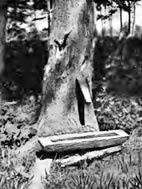The maple ceremony was held in early or mid-March when the sap from the tree began to flow.

Maple sap extraction
With knives, a cut of about two or three fingers in diameter and a long palm was made, then a stick was placed to direct the sweet liquid to a container.
The collected sap was boiled in jars and then used as a sweetener and energizer. After several days of activity, it was time for the festival to thank the creators. Sacred dances were performed and the tobacco burned so that its fragrant smoke reached the spirit world of heaven, while the speakers honored the maples.
The legend Fendilles, or legend iroquois
On a beautiful cold and sharp morning, a long time ago, a chef Iroquois named Woksis came out of his hut. Since he had to go hunting, he pulled his tomahawk (axe) from the maple tree in which he had planted it the night before. The tomahawk had made a deep cleft in the tree but Woksis paid no attention. He went hunting. A birchbark container sat at the foot of the maple tree. Drop by drop, the sap that looked like water flowed out of the gash made in the trunk of the maple tree and filled the container.
The next day, Woksis' wife noticed that the container was full. Thinking that the colorless sap was water, she used it to make a game stew. In the evening, at supper, Woksis smiles and says to his wife: “This stew is delicious. It tastes sweet. ” Not understanding it, the woman dipped her finger in the stew that had simmered all afternoon. Woksis was right: the stew was sweet. We had just discovered the sweet cracks that give us good maple syrup.
Our ancestors imitated the Indians. At the very beginning, we made a slit with an ax in the maple, then we fixed a small piece of wood or sheet metal to let the water flow into a small birch bark box called a bark cassot. Since then, maple syrup manufacturing techniques have evolved a lot, but the results are no less DELICIOUS.

Origin of sugars
Long before the arrival of European settlers in North America, Native American tribes in eastern Canada and the northeastern United States were said to have discovered how to collect sap from maple trees and turn it into syrup. Some say that the dogs of the Amerindians, by their behavior, would have put the flea in the ear of their masters: a branch had broken and the dogs were jostling all around to lick the sap which flowed, and this is how the Amerindians had the idea to taste it.

Another version says that a little squirrel climbed up a tree trunk and bit a branch… and began to drink. A Native American at the bottom of the tree was looking at him and wondering why, since a spring of fresh water was flowing nearby. He imitated the squirrel by slitting his knife… what a surprise! Until then, his tribe found sugar only in wild fruits. And here is a tree weeping sugar in crystal tears. In addition, he had just discovered a cure for the scurvy which his family often suffered in the spring. All because he had watched and imitated a squirrel quenching its thirst with maple sap ...
Marie-Victorin, a great naturalist and scholar from Quebec, illustrious author of La Flore laurentienne, bluntly affirms that the Amerindians learned from the red squirrel of the existence of maple syrup and taffy. In fact, when a branch of sugar maple breaks under the weight of the ice, the injury caused sinks in the spring. From this natural cut, the sap always follows the same path, sometimes even to the foot of the tree. Day after day, the hot spring sun evaporates the water and there is only a trail of maple taffy left that the red squirrels greedily lick.

The car.
Native Americans called it "wax sugar". It was again the red squirrel that showed men this other maple delight. When a sugar maple branch breaks under the weight of the ice, it forms a natural gash from which the sap flows in the spring. It always follows the same route, sometimes even to the foot of the tree. Day after day, the hot spring sun evaporates the water and there is only a trail of maple taffy left that the red squirrels greedily lick. Just pour the boiling maple syrup over the snow. It coagulates in the form of a soft paste. Using a stick or a wooden spatula, it is rolled up and eaten immediately. A real treat.

The legend of Nokomis
UNative American legend attributes the discovery of maple sugar to Nokomis (the Earth), grandmother of Manabush, hero of many legends Indian.
Nokomis would have been the first to drill holes in the trunk of maple trees and collect the sap. Manabush, realizing that this sap was ready-to-eat syrup, went to his grandmother and said to her, “Grandma, it is not good that trees produce sugar so easily. If men can thus effortlessly collect sugar, it will not take long for them to become lazy. We must try to make them work. Before they could taste this exquisite syrup, it would be good if the men were forced to split wood and spend nights watching the syrup cook.
He said no more, but, fearing that Nokomis would be indifferent to his words and that she would fail to take measures to prevent men from becoming lazy, he climbed to the top of a maple tree with a vessel. filled with water and poured the contents inside the tree itself, thus dissolving the sugar that was in the maple.